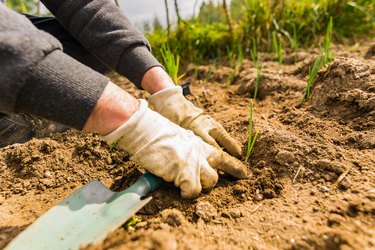
Children on road trips are always asking, "Are we there yet?" The adult version of this happens in early spring when gardeners just can't wait to turn that soil. You look out at the morning sunshine and ask, "Is it time yet?"
It's hard to have patience in March, even though you know that you're months away from garden tomatoes. Online planting calendars give you a basic outline of when to sart, but that last frost date seems so far away!
Video of the Day
Video of the Day
Is cheating the calendar possible? What can you plant when it's really too soon to be putting in garden staples? I am just as impatient as any other gardener, so I've found the answer to both of these questions. (And yes, cheating is perfectly acceptable!)
Vegetables & Herbs to Plant In Early Spring
Lettuce | Sow seeds when soil is at least 40°F |
Beets | Sow seeds when soil temp is at least 40°F |
Sweet peas (edible) | Sow seeds when soil is at least 34°F |
Radishes | Sow seeds when soil is at least 39°F |
Carrots | Sow seeds in a very sunny location when the soil is at least 39°F |
Dill | Sow seeds 5 weeks before last spring frost |
Parsley, chervil, chives | Sow seeds 4 weeks before last spring frost |
Thyme, sorrel, lemon balm | Sow seeds 3 weeks before last spring frost |
How Warm Is Warm Enough?
In cold-winter areas, nature puts the brakes on spring gardening. You can't plant seeds or veggie starts in frozen soil! Experts advise waiting to seed until a few days or weeks after the last frost date, and until the soil warms up to optimum germination temperatures. But while those are general rules, they aren't absolutes. All gardens are not identical, and some veggies are more flexible than others. Impatient gardeners have options, even in March!
The optimum germination temperature — the soil temperature at which 100 percent of seeds germinate — is 80°F, and that may not happen until July or August. But if you're like me, you don't want to wait until midsummer to plant your garden. So forget these "lines in the sand" and take the matter into your own hands.
To figure out the first possible moment to plant, all you need is a soil thermometer, available at your local garden store. The minute the soil temperature hits the minimums for cool season veggies, herbs and annuals, go ahead and get your hands dirty!
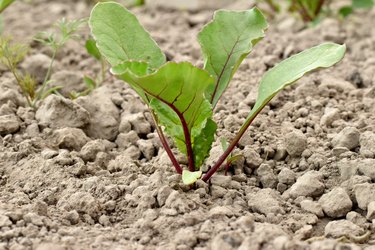
Cool-Season Veggies
You may be dreaming of tomatoes and peppers, but these garden staples are not in the cards for early spring. Instead, think cool-season veggies. This hardy group includes family favorites like beets, cabbage, spinach, carrots, onion sets, lettuce, peas, and radishes, all of which can be planted when temperatures rise just a little above freezing. They can germinate with soil temperatures from 34 degrees F (peas and onion sets) to 39°F (lettuce and beets.) You may not get 100 percent germination of the seeds, but you can average 70 percent, and that is just fine for most gardens.
Many other vegetables can be planted well before the last spring frost. These include broccoli, cauliflower, and cabbage if soil temperatures rise.
Our five top choices for early spring vegetables:
- Lettuce (Lactuca sativa) Plant lettuce seeds in the ground or in containers. The seeds can germinate when soil temperatures hit 40°F, and spring is a great time for planting since the cool days won't cause these greens to bolt. Expect baby lettuce leaves for salad in a month or so.
- Beets (Beta vulgaris)
Nutrition-rich beets double the eating pleasure, so plant them when the soil temperature hits 40°F. You can harvest the leaves for warm salads or stir-fries long before the beet roots are ready to harvest a couple of months after planting. Water these thirsty veggies well.
- Sweet peas
(Pisum sativum)
You may not think of peas as sweet if you've never had home grown, but they are truly delightful right out of the garden. The starchy version from the grocery store just can't compare. Plant peas when soil temperatures hit 34°F. The vines climb trellises without a lot of human help, and the pods harvest in 6 weeks. - Radishes (Raphanus sativus)
For a quick veggie fix, plant radish seeds when the soil hits 39°F. Seed several lines of them for multiple harvests — you can fit 16 in 1 square foot! These vegetables grow so fast that you'll be eating them in three weeks, enjoying their crisp, tender crunch. - Carrots (Daucus carota subsp. sativus)
Plant this staple in loamy soil up to three weeks before the last spring frost date. They can be planted when the soil is 39°F and need a very sunny location. Don't panic if you don't see shoots right away. They may take two weeks to germinate.
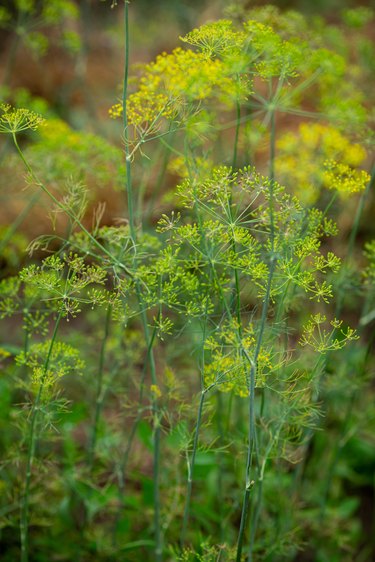
Cool-Season Herbs
You can also find cool-season herbs to put into the garden weeks before the last spring frost date. If you are five weeks before the last spring frost, plant dill. Four weeks before? Go for parsley, chervil and chives. At three weeks prior to the final frost of the season, seed thyme, sorrel, or lemon balm.
Almost any other herb can be seeded just after the final frost of spring. These include basil, oregano, borage, cilantro, rosemary, and summer savory.
Note that you can't expect immediate action here; these seeds will be fine in the ground, and you'll be happily occupied planting them. But don't do what I did and check for growth every day. The seeds won't germinate until soil temperatures get to 70°F.
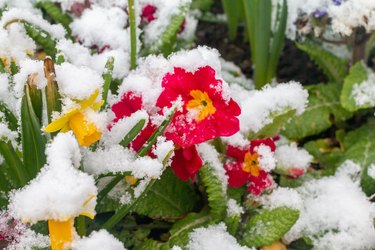
Cool-Season Annuals
Annuals are the rock stars of the flower garden, living fast and dying young. They only last one season, but they give it their all with speedy growth, vibrant colors and a long flowering season.
Most cool-season annual flowers can be seeded in or transplanted into the garden before the spring's final frost. If you hear that an extended cold spell is expected, cover the bed with mulch.
There are many annual flowers to choose between. Here are three favorites I'm putting in this spring:
- Nasturtiums (Tropaeolum spp.)
I can't resist any flower that is brilliant orange, and the nasturtiums in my yard seem to blaze with inner fire. These amazing flowers bloom almost the entire year in some areas, from early spring through Thanksgiving. Plant the vining kind and they turn into groundcover or climb along fences or walls. Nasturtium needs full sun and well-draining soil, and you choose from orange, red, yellow, or variegated shades. The blossoms are edible and lovely in salads. - Violas (Viola spp.)
Violas, with their cute blossoms in bright shades, are uniformly delightful, from pansies (Viola x wittrockiana) to violets (Viola sorolia). They flower quickly and bloom for months on end. Deadhead them as they wilt to make room for new flowers. They need full sun and excellent drainage, and they come in remarkable colors, from tender lilac to jewel-toned violet, brilliant blue, canary yellow, white, and cream. - Bachelor's Buttons (Centaurea cyanus) These are tough to find as flower starts, but seeds are available in most garden stores. Bachelor's buttons are usually bright blue, but you can find seeds for purple or pink blossoms as well. The bright flowers are dainty but tough as nails. As long as they get some sun and good drainage, they will light up your spring and rebloom in autumn, reseeding abundantly.
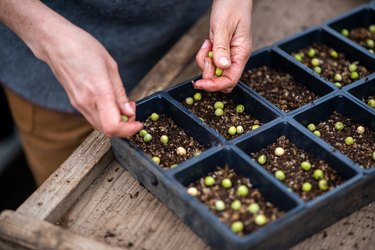
Tips for Early Spring Gardening
There are days you simply cannot get outside and get seeds planted. Either it's too cold, too rainy, or too windy. When that happens, you can still get your garden vibes going by using one or more of these tips.
- Get ready, get set, grow
Gardeners need tools, and if you didn't clean and organize your cultivation tools in autumn, take the time to do it now. Wash them down, then take a wire brush to the wooden handles. When the handles are dry, apply mineral oil. Also, inspect your seed supply and buy or order what you need.
- Sow seeds in pots
If your desires are truly untimely — and the urge to garden strikes well before the soil warms — "contain" your hopes. No, I don't mean stifle those gardening urges but rather focus them on container planting. If you plant veggies in pots (lettuce works well in containers) and flowers in pots (any hardy annuals or bulbs will do), you can cart them indoors at night until nature gets around to warming up the world. - Plant seeds indoors
Planting seeds indoors allows you to work the soil and make little plants grow without setting foot in the backyard. It's more work than buying starts when the weather warms, but the selection is so much greater and the cost so much lower when you buy seeds.
Start seeds indoors in regular potting soil or seed-start soil. You can plant many seeds in a large, recycled pot, but I like to use plug trays — flat containers with a separate space for each seed. You just sow the seeds in the pockets and grow them there until they are ready to plant outdoors.